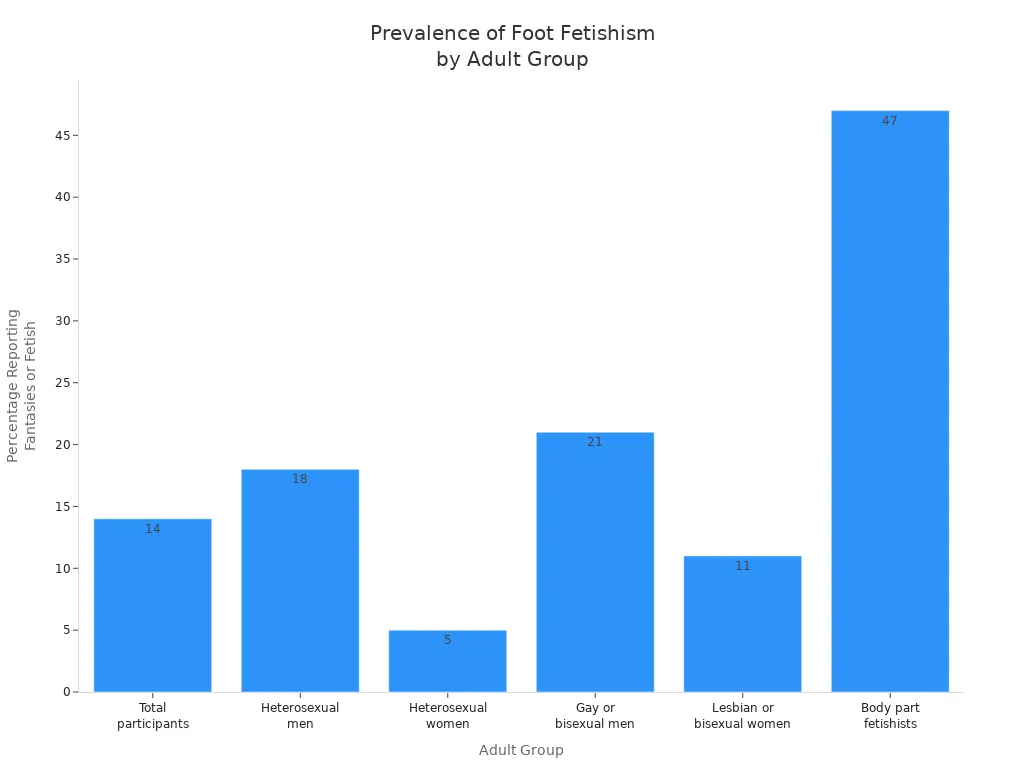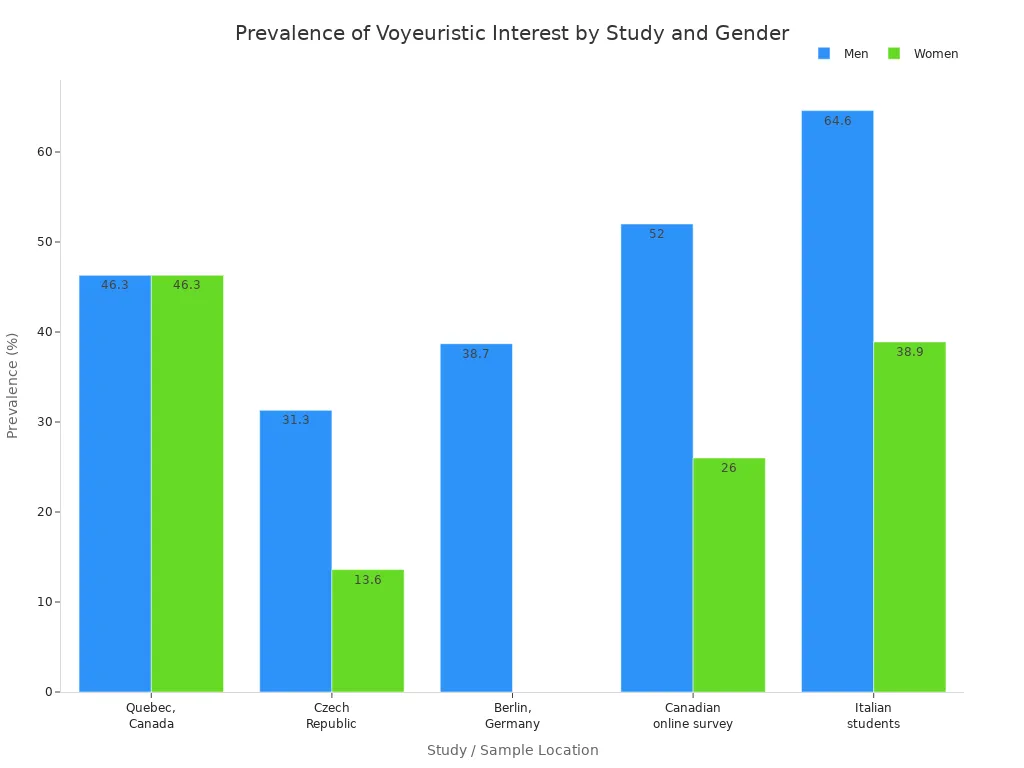The Ultimate List of Sexual Fetishes and Kinks You Should Know

Are you wondering about fetishism sex or why some fantasies excite you? You are not the only one. Many grown-ups try sexual fetishes or kink. They might do this with dirty talk, kinky fantasies, or special pleasures. Top experts say fetishism sex is when someone feels sexual excitement from things, body parts, or acts that are not usual. A kink is a nontraditional behaviour that makes things more fun. But it is not needed for pleasure. The table below shows how common these interests are:
Gender |
% Interested in Fetishes |
% Engaged in Fetish Behaviour |
% Both Interested and Engaged |
|---|---|---|---|
Men |
54% |
54% |
|
Women |
46% |
42% |
46% |
You should enjoy your fantasy and kinky sex in a safe way. Make sure everyone agrees and feels respected. Talking openly helps people feel safe and not judged.
Key Takeaways
Fetishes and kinks are normal in human sexuality. People have many different interests. Consent, talking openly, and respect are very important. These help keep things safe and fun. Try new things slowly. Use safe words. Always put safety and aftercare first. Some fetishes and kinks, like foot fetishes or BDSM, can make people feel closer. They can build trust if you share them. You should feel proud of your desires. It is good to feel comfortable with them. Sexual diversity makes life more interesting.
Fetishism Sex
What Is Fetishism?
You might ask how a fetish is different from other sexual interests. A fetish is when someone feels strong sexual excitement from a certain object, body part, or situation. This thing can become very important for feeling aroused. Fetishism sex is when you need that special thing or act to feel turned on or happy.
Here are some well-known meanings of fetishism from experts:
Marxist thinkers say fetishism is when people give objects special power. This can hide the real ways people connect.
Freud’s psychoanalytic view says fetishism helps people deal with deep feelings. People might focus on an object to avoid emotional pain.
Feminist and cultural theories say fetishism can happen in many ways. It is not just for men. It can show bigger ideas in society or culture.
So, fetishism sex is not only about what happens in the bedroom. It links to how people think, feel, and act in the world.
Fetish vs Kink
Some people use fetish and kink as if they mean the same thing. They do not. A fetish is a strong and sometimes needed focus on a certain object or act for sexual pleasure. If you have a fetish, you might find it hard to get aroused without it. Kink means many unusual or playful sexual behaviours. You might like a kink, but you do not need it every time.
Experts say people often misunderstand kink because of old taboos. Many think kink is odd or bad, but studies show people who enjoy kink are just as healthy as others. Kink can help you feel closer to your partner. It can make you feel more confident or let you try new things. Fetishism sex is more focused, but kink is about making things more fun and different.
Most people have some kind of fetish or kink. Studies show about 27% of people think about fetishism sex. It is more common in men. Foot fetishes are very popular. These interests are normal. They are only a problem if they cause upset or harm.
Population Group |
Prevalence of Fetishistic Fantasies |
Prevalence of Fetishistic Activities |
Notes |
|---|---|---|---|
Men |
14% to 30% |
24.5% |
Fetishism sex is more common in men; includes feet, objects, clothing |
Women |
0% to 26.3% |
N/A |
Women report fewer fetishistic fantasies |
General |
~27% fantasise about fetishism sex |
N/A |
Fetishism is more common than some other sexual interests |
You do not need to feel odd if you have a fetish or like a kink. These are just parts of human sexuality. They are more common than you might think.
Sexual Fetishes
Are you interested in what makes people excited? You are not the only one. Lots of people have a favourite fetish. Some fetishes are very common. Others are more rare or special. Let’s see some popular sexual fetishes and what makes them different.
Foot Fetish
A foot fetish is very popular. People might like feet, toes, or painted toenails. Some enjoy touching or kissing feet. Others like to give foot massages. Many people look at feet or shoes in pictures or videos. This fetish is called podophilia.
Here is a table showing how many adults like foot fetishism:
Group |
Percentage Reporting Sexual Fantasies Involving Feet or Toes |
|---|---|
Total participants |
|
Heterosexual men |
18% |
Heterosexual women |
5% |
Gay or bisexual men |
21% |
Lesbian or bisexual women |
11% |
Among those with body part fetishes (podophilia) |
47% report a fetish for feet or toes |

Why do people like feet? Some experts think it starts when you are young. Others say it is just what you prefer. If you like this fetish, talk to your partner. Make sure they are happy with it.
Tip: Always ask before you touch someone’s feet. Consent makes things better for everyone.
Shoe and Clothing Fetish
Do you get excited by shoes or clothes? You are not alone. A shoe or clothing fetish can be about high heels, boots, stockings, leather, or underwear. Some people like how these things look or feel. Others enjoy the smell or wearing them. Some like to see others wear them.
Famous designers use fetish fashion in their work. Punk and leather styles became cool in the 1970s and 80s. TV and pop stars made corsets and leather jackets popular. Some people like clothes that are tight or hard to move in. This can make things feel more exciting or controlled.
Fetish clothes like corsets and leather used to be secret, but now they are in fashion shows.
Punk and street styles made fetish fashion popular for everyone.
High heels, boots, and stockings are seen in both fashion and fantasies.
Some people like the feel of leather or rubber. Others like strong women in dominatrix outfits.
If you have a shoe or clothing fetish, you might like shopping for special things. Dressing up for your partner can be fun. The main thing is to enjoy yourself and feel good.
Hair Fetish
A hair fetish is called trichophilia. It means you find hair exciting. You might like long hair, curly hair, or a certain colour. Some people like to touch, brush, or pull hair during close moments. Others enjoy looking at hair or watching shampoo adverts.
You might have liked hair since you were young.
Some people enjoy the smell or feel of hair.
Watching someone style their hair can be exciting.
Hair pulling can be part of rough play, but always check your partner is happy.
If you have a hair fetish, talk to your partner about it. Make sure you both feel safe and respected.
Object Fetish
An object fetish means you get excited by things that are not body parts. Shoes, gloves, leather, rubber, skirts, and even nappies can be the focus. Some people like how these things look or feel. Others enjoy using them in a sexual way.
Fetish Object Category |
Common Examples |
|---|---|
Footwear (shoes) |
High heels, boots, trainers |
Leather |
Jackets, trousers, skirts |
Rubber |
Latex clothing, gloves |
Gloves |
Leather or rubber gloves |
Female undergarments |
Panties, bras, soiled underwear |
Skirts |
Mini skirts, hobble skirts |
Diapers |
Adult nappies |
Body parts |
Feet, hands, hair, tattoos, piercings |
You might like collecting these objects or using them during sex. Some people enjoy the smell or feel. If you want to try something new, talk to your partner. Make sure you both agree.
Giantess Fetish
Have you ever thought about someone much bigger than you? The giantess fetish is about size difference. You might like stories, art, or videos with a giant woman in charge. This fantasy mixes power, submission, and play.
There are online groups for people who like this fetish. People write stories, draw pictures, and roleplay as giant characters. Some use this fantasy to think about power or who they are. The giantess community is friendly and welcomes everyone, including queer or neurodivergent people.
Many people share giantess stories and art online.
Some use the fantasy to feel strong or work through feelings.
The community supports safe, respectful play and welcomes all.
If you are interested in this fetish, you can join online groups or read stories to learn more.
Merinthophilia
Merinthophilia is not very common. It means you get excited by being tied up or tying someone else up. This can use ropes, scarves, or belts. The main idea is about restraint and trust.
You might like feeling helpless or in control. Some people like how knots look or how tight things feel. If you want to try merinthophilia, talk to your partner first. Make sure you both agree on what is safe and fun.
Safety tip: Always have a way to get free quickly. Keep scissors nearby and never leave someone tied up alone.
Sexual fetishes come in many types. Some, like foot or shoe fetishes, are very common. Others, like giantess or merinthophilia, are more rare. No matter what your fetish is, the most important thing is to be safe and respect everyone.
Sexual Kinks
You might have heard people talk about sexual kinks and wondered what they really mean. Kinks are playful or unusual ways to enjoy sex. They are not the same as a fetish, which is when you need a certain thing to feel aroused. With a kink, you can enjoy it sometimes, but you do not need it every time. Many people try kinks to add excitement, build trust, or explore new sides of themselves. Let’s look at some of the most common kinks and see how they work.
BDSM
BDSM stands for Bondage, Discipline, Dominance, Submission, Sadism, and Masochism. You might see it in films or books, but real-life bdsm is all about trust, consent, and fun. People use bdsm to explore power, control, and sensation. You can try light spanking, dirty talk, or more intense scenes with restraints and role play.
Here is a table showing some popular forms of bdsm and how they fit into different categories:
BDSM Form |
Category |
Description |
|---|---|---|
Bondage and Restraint |
Physical Restraint |
Restricting movement using ropes, cuffs, or furniture to create power dynamics. |
Orgasm Denial and Chastity |
Psychological Control |
Controlling or delaying climax to create power exchange and emotional intensity. |
Power Exchange and Role Reversal |
Dominance & Submission |
One partner takes control while the other submits; includes role play like teacher-student or pet play. |
Sensation Play |
Sensory Stimulation |
Using different touches, temperatures, or textures (feathers, ice, wax) to heighten arousal. |
Voyeurism and Exhibitionism |
Visibility Dynamics |
Thrill from watching or being watched, involving consented exposure or observation. |
You do not need to try everything at once. Many people start with simple things like blindfolds or gentle spanking. The most important thing is to talk with your partner and agree on what feels good and safe.
Tip: Always use a safe word. This is a special word that means “stop” if you feel uncomfortable.
Bondage
Bondage is one of the most popular kinks. It means tying up your partner or being tied up yourself. You can use ropes, scarves, cuffs, or even special furniture. Some people love the feeling of being held in place. Others enjoy the power of being the one in control. Bondage can be soft and playful or strict and serious.
If you want to try bondage, follow these steps for safety:
Talk openly about what you want and what you do not want.
Set clear boundaries and agree on a safe word.
Start with simple knots and soft materials.
Learn together and check in often.
Make sure restraints are not too tight and can be removed quickly.
Keep safety scissors nearby in case you need to cut something fast.
Never leave your partner alone while tied up.
After you finish, talk about how you both felt.
You can make bondage part of a bigger fantasy or just enjoy the feeling. Remember, consent and safety come first.
Dominance and Submission
Dominance and submission, often called D/s, is a kink where one person takes control and the other gives up control. You might like being the boss, or you might enjoy following orders. Some people use titles like “Sir,” “Mistress,” or “pet.” Others keep it simple with dirty talk or gentle commands.
Research shows that dominance and submission can make relationships stronger if both people agree on the rules. Some couples feel closer and more satisfied when they explore power together. The key is to match your beliefs and actions. If you both want the same thing, you are more likely to feel happy and safe.
Some people like to switch roles and try both sides.
You can use dominance and submission in the bedroom or in daily life.
Always talk about what you want and check in with your partner.
Note: Dominance does not mean being mean or cruel. It is about trust, care, and respect.
Sensation Play
Sensation play is all about exploring how different touches feel on your skin. You can use feathers, ice cubes, silk, or even hot wax. Some people like gentle tickling, while others enjoy stronger feelings like spanking or scratching. Sensation play can be soft and loving or wild and intense.
Here is a table with some types of sensation play and how to stay safe:
Type of Sensation Play |
Examples |
Associated Risks and Safety Measures |
|---|---|---|
General Sensory Play |
Blindfolds, feathers, silk, tickling, whispering, kissing, warm baths |
Low risk. Always check comfort and get consent. |
BDSM-Related Sensation Play |
Hot wax, ice, biting, flogging, clamps, mummification, suspension |
Higher risk. Use proper tools, talk about limits, and follow “safe, sane, and consensual” rules. |
Before you start, talk about what you want to try. Ask your partner about their favourite sensations and what they do not like. Always use safe supplies, like candles made for wax play. Never use regular candles, as they can burn the skin.
Safety tip: Always have a plan for aftercare. This means cuddling, talking, or anything that helps you both feel good after the scene.
Role Play
Role play is when you pretend to be someone else during sex. You might act like a teacher and student, boss and employee, or even a superhero and villain. Role play lets you explore fantasies and try new things in a safe way. You can use costumes, props, or just your imagination.
Role play helps couples break out of routine and feel closer. It brings excitement and can make you laugh together. Studies show that playful activities like role play help couples feel more satisfied and connected. You can use dirty talk to make the scene feel real or set up a whole story with your partner.
Choose a fantasy that excites you both.
Set clear rules and safe words.
Try different roles and see what you like best.
Remember: The goal is to have fun and feel safe. If something feels wrong, stop and talk about it.
Age Play
Age play is a kink where you or your partner pretend to be a different age. Some people act younger, like a “little,” while others take on a caring “big” role. Age play is about comfort, trust, and sometimes letting go of adult worries. It can include cuddling, gentle care, or playful rules.
You do not have to use sex in age play. Many people just want to feel safe and cared for. If you want to try age play, talk about what feels good and what does not. Always make sure everyone agrees and feels respected.
Pet Play
Pet play is a kink where you pretend to be an animal, like a puppy, kitten, or bunny. One person acts as the pet, and the other is the owner or handler. Pet play can be silly and fun or serious and strict. Pup play is the most popular form, but you can try any animal you like.
You can switch roles or stick to one.
The pet play community values consent, body positivity, and self-expression. You should always talk about what you want to try and set clear limits. After a session, check in with your partner and talk about what you liked or did not like.
Note: Pet play is about trust and care. Always respect each other’s comfort and boundaries.
You can see that sexual kinks come in many forms. Some people like bondage, others enjoy role play or sensation play. The most important thing is to talk, agree on rules, and look after each other. Kink is about fun, trust, and exploring new sides of yourself. If you are curious, start slow and see what feels right for you.
Voyeurism and Exhibitionism
Voyeurism
Have you ever wanted to watch others in private? This is called voyeurism. Some people get excited by seeing others undress or have sex. They might like it more if the person does not know they are being watched. Many adults are interested in this. Studies from different countries show voyeurism is common, especially for men.
Country / Study |
Men (%) |
Women (%) |
|---|---|---|
Quebec, Canada |
— |
|
Czech Republic |
31.3 |
13.6 |
Berlin, Germany |
38.7 |
— |
Canadian online survey |
52 |
26 |
Italian students |
64.6 |
38.9 |

You might ask if this is normal. Research says it is. Voyeuristic fantasies are more common than many other sexual interests. One study found 79% of people would try voyeurism if they would not get caught.
Note: Consent is very important. Watching someone without their permission is against the law. It also breaks their privacy. Always make sure everyone agrees and feels safe.
Some people like consensual voyeurism. They might watch their partner or share videos together. You can enjoy this kink safely by talking first and making clear rules.
Respect privacy and never record or share without asking.
Never involve anyone who is underage.
Exhibitionism
Exhibitionism means you feel excited by showing your body or sexual acts to others. You might like flashing, sending nudes, or having sex where someone could see you. Some people enjoy being noticed or surprising others.
In psychology, exhibitionism is when someone gets excited by exposing themselves to people who do not expect it. Some do this to get attention or feel strong. Others do it to help with feeling unsure about themselves. The act is often planned. Some people enjoy thinking about it after more than during.
Reasons can be wanting to shock, get approval, or enjoy self-humiliation.
Exhibitionism is only a problem if it upsets you or involves people who do not agree.
Tip: If you want to try exhibitionism, pick safe places like private parties or online groups where everyone agrees.
Legal and moral rules are important here:
Always get clear, happy consent.
Never involve children.
Respect everyone’s privacy and limits.
You can enjoy exhibitionism in a safe and fun way if you follow these rules. Remember, consent and respect are what matter most.
Group and Public Play
Threesomes
Have you ever thought about adding a third person to your bedroom fun? Threesomes are one of the most talked-about group experiences. Many people find them exciting because they offer something new and different. You might feel more confident, explore new fantasies, or even test your relationship in a safe way. Some people enjoy the chance to try same-sex experiences or just want to share pleasure with more than one person.
However, threesomes can also bring challenges. Jealousy, hurt feelings, or confusion about roles can happen. You might worry about what others think or feel unsure about privacy. To make things easier, talk openly with everyone involved. Set clear boundaries, use protection, and check in with each other before and after. Remember, consent and comfort matter most.
Tip: After a threesome, spend time together to talk about how you feel. This helps everyone feel safe and respected.
Group Sex
Group sex means having fun with more than two people at once. Some people join parties or private gatherings to meet others who share their interests. These events can help you explore new sides of yourself and meet like-minded friends. In some communities, people use drugs to feel more relaxed or confident during group play. This is called "party and play" or "chemsex". It can help reduce worries about body image or performance, especially in gay male groups. But remember, using drugs can bring health risks, including a higher chance of catching infections.
Always look after your health. Use condoms, get regular STI checks, and talk honestly about what you want and do not want.
Swinging
Swinging is when couples swap partners or play with others, often at special parties or clubs. You and your partner might set rules to keep things safe and happy. Some couples only swing together, while others have limits on what they do. Good communication is key. Talk about your feelings, set clear boundaries, and check in often.
Always get clear, enthusiastic consent.
Use protection and talk about sexual health.
Respect privacy and never share details outside the group.
Go at your own pace and support each other.
Note: Swinging works best when you both feel secure and open with each other.
Public Play
Public play means doing something sexual where others might see you. This could be as simple as flirting in a public place or as bold as having sex outdoors. Many people find the risk and excitement thrilling. If you want to try public play, choose safe places and make sure everyone agrees. Never involve anyone who does not want to take part.
Remember, laws about public sex are strict in many places. Always respect others’ privacy and safety. If you want to explore, look for events or spaces where public play is allowed and everyone is on board.
Risk and Edge Play

Some sexual interests come with higher risks. You might hear people call these "edge play." These activities can be exciting, but they need extra care. You must always talk openly, agree on what is safe, and know your limits. Trust and respect are key.
Erotic Asphyxiation
Erotic asphyxiation means restricting air during sex to feel more pleasure. Some people use hands, scarves, or other items. This can be very dangerous. You risk fainting, brain injury, or worse. If you want to try breath play, never do it alone. Your partner should know first aid and watch you closely. Always agree on a safe word or gesture before you start.
Safety tip: Never use anything that could get stuck or tighten by accident. Keep scissors nearby and check in often.
Choking
Choking is a type of breath play where you press on the neck. Some people enjoy the rush or feeling of surrender. This is risky because the neck is sensitive. You can hurt blood vessels or block air by mistake. If you want to try choking, learn about anatomy first. Use gentle pressure and stop right away if your partner feels dizzy or scared.
Always talk about what feels safe.
Use a safe word or tap-out signal.
Never leave your partner alone.
Blood Play
Blood play means using blood in sexual scenes. Some people like the look or feel. This is edge play because of health risks. You must use sterile tools and never share needles. Test for bloodborne illnesses and clean wounds carefully. Aftercare is important to help you both feel safe and cared for.
Blood Play Safety Checklist |
|---|
Use new, sterile tools |
Wear gloves |
Clean wounds right away |
Test for infections |
Talk about limits |
Cuckolding
Cuckolding is when you watch your partner with someone else. This kink is more about emotions than physical risk. You might feel jealousy, excitement, or pride. It is important to talk about feelings and set clear rules. Check in with each other before and after. Trust and honesty help you both enjoy the experience.
Remember: Edge play is not for everyone. You should always use the Risk-Aware Consensual Kink (RACK) approach. Learn about risks, talk openly, and never skip aftercare. Your safety and well-being come first.
Consent and Safety
When you explore new sexual interests, consent and safety should always come first. You want everyone to feel respected, comfortable, and happy. Let’s look at how you can keep things safe and enjoyable.
Communication
Good communication is the heart of any healthy sexual experience. You need to talk openly with your partner about what you want, what you do not want, and how you feel. You can ask questions like, “Are you okay with this?” or “How does that feel?” Checking in often helps you both stay on the same page.
Associate Professor Jennifer Power says that consent is all about care and respect. You should always tune in to your partner’s comfort and safety. This means you listen, watch for signals, and talk about what feels good or not so good.
Here are some key points to remember:
Consent is not a one-time thing. You need to get it every time, for every activity.
You or your partner can change your mind at any moment. That is okay.
Enthusiastic consent means you both give clear, happy signals—words, smiles, or nods.
Your body might react in ways you do not expect. That does not mean you have agreed.
Safe Words
Safe words help you and your partner stop or slow down if something feels wrong. You can pick any word, but many people use “red” for stop and “yellow” for slow down. When you hear a safe word, you stop right away and check in.
Safe Word |
Meaning |
|---|---|
Red |
Stop now |
Yellow |
Slow down/check |
Green |
All good |
Safe words make it easier to try new things because you know you can pause at any time.
Aftercare
Aftercare is what you do after sex or a kinky scene to help each other feel safe and cared for. You might cuddle, talk, have a snack, or just sit together. Aftercare is a planned way to connect and check in. It helps you both feel good and respected.
Ask your partner how they feel.
Make sure they feel safe and happy.
Talk about what you liked or did not like.
Aftercare keeps the conversation going. It helps you learn what works and what does not. This is especially important if you try high-risk activities. You want to make sure everyone leaves feeling safe, respected, and valued.
There are lots of different sexual fetishes and kinks people like. These interests are normal for humans. It is important to talk honestly with others. Set clear rules so everyone feels safe. If you are curious, you can explore what you enjoy. Do not feel embarrassed about your desires.
Be proud of what makes you different—sexual diversity makes life more interesting and fun. You should always get respect and pleasure, no matter what you enjoy. 🌈
FAQ
What if I feel embarrassed about my fetish or kink?
You are not alone. Many people feel shy at first. Your interests are normal. You can talk to someone you trust or join online groups. Remember, you deserve respect and kindness.
How do I talk to my partner about my kink?
Start with honesty. You can say, “I want to share something important.” Ask your partner how they feel. Listen to their thoughts. Use simple words and stay calm. Respect their feelings.
Is it safe to try new kinks?
You can keep things safe by talking first. Set clear rules. Use safe words. Start slow and check in often. If you feel unsure, stop and talk. Safety always comes first.
Can I keep my fetish private?
Yes, you can. You choose who to tell. Many people keep their interests private. If you join online groups, use a nickname. Protect your privacy and only share what feels right.




